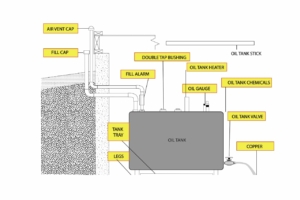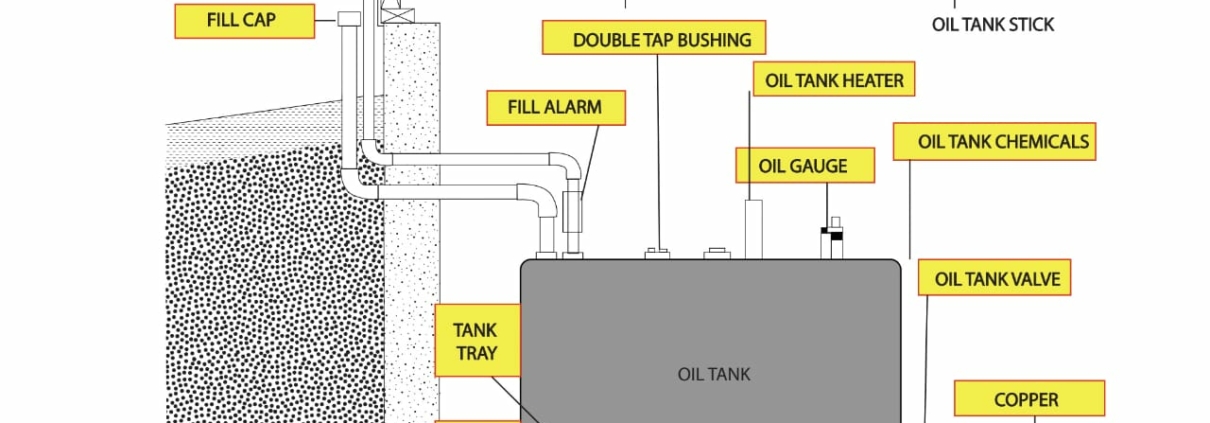Oil Tanks
Oil tanks are mainly used for commercial and industrial settings. But, they find their places even in domestic settings. People do use oil heat, especially in cold regions, for which they need an oil storage tank.
These tanks may sound simple, but they have versatile designs and components. And thus, oil tanks are never limited to a single context.
Read on to learn about oil tanks and their important aspects.
What are Oil Tanks?
To put it simply, oil tanks provide spaces for oil storage. The tanks act as a reservoir or a container, storing the oil during different stages of processing or making different oil-based products. Moreover, they can store oil prior to its use or consumption.
They are mainly composed of steel, fiberglass, or plastic. Steel tanks can be used for storing oils above or under the ground. Another alternative to these materials is building tanks made of concrete.
Among plastic and steel varieties, the former provides advantages like suitability for processing and low weight, which makes installation or replacement comparatively easy. But, steel components offer overall better services as materials for oil tanks due to greater resistance to harsh weather and durability against accidental harm.
However, combination materials can offer better service based on reliability and sturdiness. In combination tanks, polyethylene composes the inner tank. And galvanized steel builds up the outer tank.
The size of oil tanks have a broader range. Some tanks can be small and hold 250 gallons while large tanks can store fuel in excess of 30,000 gallons.
Here it’s worth noting that the capacity of home tanks differs from that of industrial tanks. The average holding capacity for domestic oil tanks is 275 gallons.
How Do Oil Tanks Work?
How the tank works depends on its context of use. It is used for storing or processing oils in an industrial or commercial setting. And thus, tanks in those settings come with different accessories and helping equipment. And hence these tanks may have varied mechanisms compared to the ones installed for residential use.
Here we shed light on the working of the home oil tank, which is involved in generating oil heat. And the tank functions as a part of a heater or heat-generating system, which can be either furnace or a boiler.
The thermostat senses the drop in temperature. And it gives a signal to the heater installed in your home. The oil travels from the tank through pump lines to feed the flame produced by the heating appliance burner. Sufficient oil must be present in the tank to maintain proper operations. The tank fails to transfer thermal energy if the oil level falls below the minimum level.
What Happens if You Let Your Oil Tank Run Empty?
First of all, letting your oil tank run empty means that enough fuel is not getting supplied to the furnace or boiler. Naturally, the heating system will not be able to produce the required heating for your home. So, you may have problems fetching hot water when needed on an emergency basis.
Secondly, an empty oil tank can be the reason behind a clogged filter, causing disruption or complete breakdown in the functions of the furnace or any other heating system. Also, when the oil tank is empty, impurities and air can gather in the feed line due to clogging in the filter. This blockage can prevent the heating system from functioning even after the oil tank has been filled.
Finally, unwanted water accumulation can happen in an empty oil tank from humid air. This water collection can cause rust formation inside the tank and ultimately weaken the tank.
How Does the Oil Gauge Help in Ensuring that the Oil Tank is Never Empty?
The primary function of an oil gauge is to let you know how much oil is remaining in the tank. As a result, you get to know at the right time when the tank needs to be refilled. Smart oil gauging systems today can even keep you informed by sending notifications to your smart devices.
An oil gauge will help detect any problem in the tank. For example, if your gauge shows that the oil levels have fallen unnecessarily, it may be an indication of leakages and damage to the tank or your heating equipment. In such cases, you can arrange an oil inspection for proper diagnosis and solution.
In addition, an oil gauge helps to know how much heating oil is being used in your house throughout the year or for specific seasons. This will let you know in which months the most amount of heating oil is required in your house and anticipate how much the energy bill may hike during that time. In such cases, the HVAC contractor near you may suggest insulating your home to keep the electricity bill in check.
Types of Oil Tanks
The varieties mentioned below differ on the location of installation, and structural aspects.
Single Wall Tank
This refers to one of the most commonly used types and has a single layer for protection against oil leaks. These types are less costly but come with shorter life spans.
Double Wall Tank
As the name implies, these tanks have a dual layer for leakage protection, providing more durable storage than single walled tanks.
Integrally-bunded Tank
This is one of the safest types among oil tank varieties. The attached bund serves as a secondary catch for the fuel storage and base of the tank in the event of a leak.
Oil Tanks Components
Oil tanks have many components and during an inspection, the inspector will assess each part. These components are the vent-pipe, vent whistle, oil gauge, oil tank, shutoff valve, tank legs, fuel line, fill pipe, and tank filter.

Vent-Pipe
The vent pipe will perform ventilation as the oil travels from the oil tank to your house. Vent-pipes are usually one to two inches in their width.
Vent Whistle
A vent whistle ensures safety while refilling the oil tank. It makes a sound so that the delivery person knows when the tank is full.
Oil Gauge
The oil gauge reads and tells you how much oil is there in the tank. Usually, the gauge will indicate an E or 0 mark to show the tank is empty.
Oil Tank
This is, of course, the space where the oil will remain stored in the tank.
Shutoff Valve
This component is extremely helpful to automatically cut off the oil supply to an appliance in the event of a fire.
Tank Legs
Tank legs ensure that the entire set up in its place and the tank level is maintained. That is why it is important that tank legs are properly maintained and do not gather rust.
Fuel Line
Fuel lines help the fuel in the oil tank to move to the heating appliance.
Fill Pipe
The tank is filled with oil with this pipe. It also makes sure that water accumulation does not occur inside the tank.
Tank Filter
The tank filter eliminates dirt and different particles from the oil. This filtering is necessary to stop debris from clogging the oil line and internal components of the heating appliance.
Underground Oil Tanks
The time spanning from the 1930s to the 1980s experienced a high prevalence of underground oil tanks. However, during the 1960s and 1970s, concerns about the corrosion of these tanks emerged. Starting from 1970 to 1990, technological interventions brought initiatives to safely store oils underground.
Underground tanks hold special importance for homeowners, buyers, and sellers. Older homes may have unused oil tanks abandoned underground, which often go undetected. And that can become a liability for new buyers.
Moreover, the associated pipes and networks increase the risk of leakage. The surrounding water bodies and soils can become contaminated and impact the health of those residing in the affected area.
Further, having an oil tank underground may bring down the value of your property. Potential buyers can associate the presence of a tank in your home with contamination if you fail to provide proper documents.

Cost to Remove an Underground Oil Tank
The cost of removing an underground oil tank is higher than that of removing an above-ground one. An examination of a tank placed underground generates a bill of approximately $500. The average price for its removal can range from $2000 to $5000. However, the pricing may vary depending on the capacity of the tank.
Alternatively, you can choose to keep the tank underground, ensuring its proper processing, instead of removing it from the site. And this, known as oil tank abandonment, involves cutting open the tank and washing and draining it. The abandonment process also involves filling the tank with dirt or foam. The whole procedure can typically range somewhere between $1000 and $3000.
Things to Consider During Installing Oil Tanks at Home
- Your requirement for thermal energy is based on the number of rooms and size of your building.
- Understanding of your household consumption
- Size and the maximum capacity of the oil tank
- The area on your property where you want to install the tank
- Guidelines and terms and conditions of the service agency you are hiring for installing or replacing these tanks
- Gathering testimonials of the agency you are hiring, if possible, from several sources
Final Thoughts
Oil tanks have various uses. They store oil for processing or other purposes. But for residential uses, they are utilized to generate heat or warm up the house’s interior. You can categorize these tanks based on installation area and design. The varieties include above-ground, underground, outdoor, and indoor types.
Also, tanks can be categorized based on the layer of protection. Examples include double-skinned and single-skinned types, and you get better protection from oil leaks from double-skinned varieties.
Home tanks function as a part of the house heating system. The oil gets heated, and the resulting warm oil transfers the heat to a heat-distributing agent, either water or air.
The cost of oil heating tanks varies based on installation and company services.




